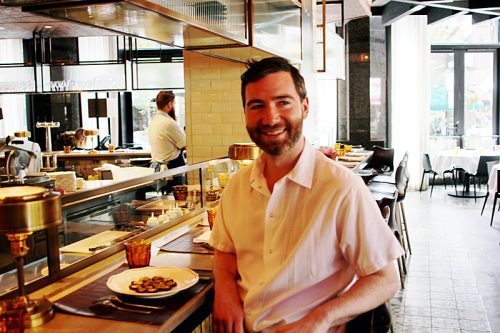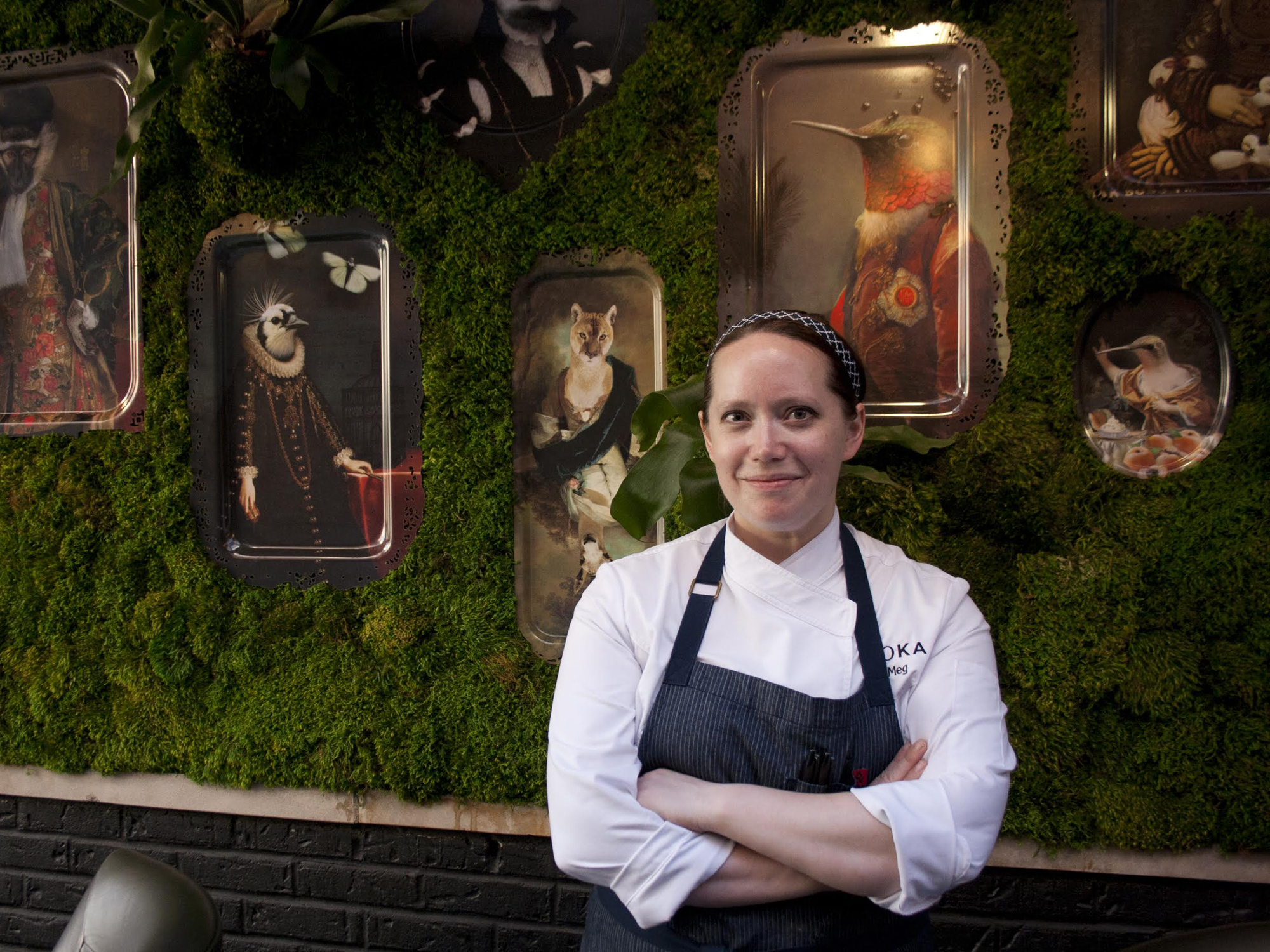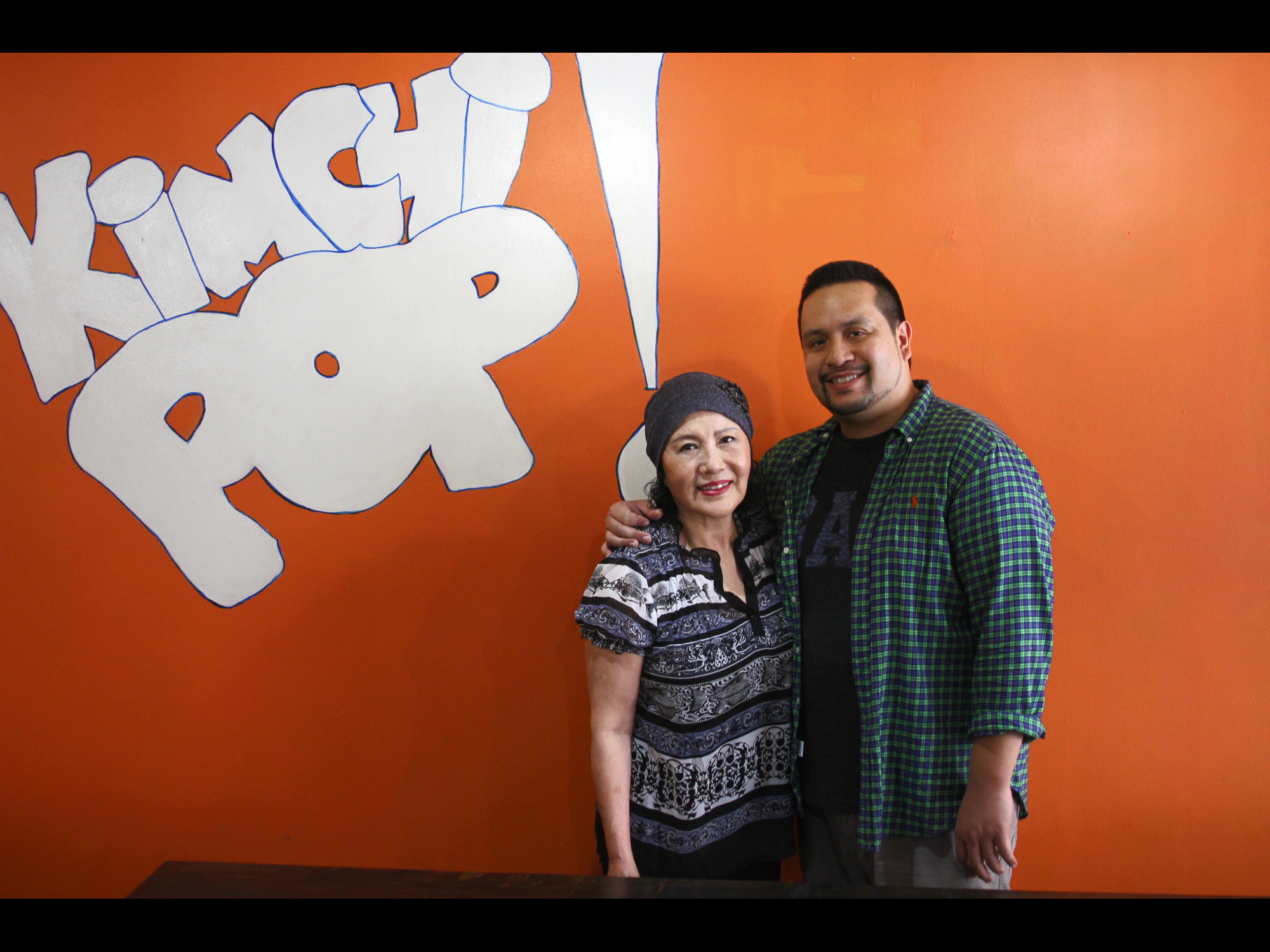IT’S A FAMILIAR THING IN HOLLYWOOD—the promising filmmaker gets his first big budget, and it bombs. Maybe the project was compromised from the beginning (see: Star Wars sequels right now). Tail between his legs, he goes back to making small-budget, personal projects—and wows the critics by reminding them why he excited them in the first place.
Bill Montagne went through the chef equivalent of that. He’d built up his credentials at top places to learn his trade, cooking under Eric Ripert at Le Bernardin, learning the operational side at Lettuce Entertain You. He opened C Chicago, a massive seafood restaurant from the Chicago Cut steakhouse group. And… it opened to a legendary hell-slam of a review from Jeff Ruby in Chicago magazine, among others.
Within half a year, Montagne left, but he left with two things: one, a relationship with co-worker Jennifer Kim, an S. Pellegrino Young Chefs Competition winner, and two, one category of menu item that had gotten good notices: a cured fish program. The three of them—Montagne, Kim, and cured fish—rebounded by opening Snaggletooth, a cafe devoted to coffee, bagels and cured fish.
And it was one of those little miracles that reminded you why dining out makes you happy. Deli food rendered with the precise quality of sushi, in a sunny cafe decorated with things from home (Kim is a Buster Keaton fan) and served with utter sincerity and openness, a million miles from the games a big seafood house played. A year after they left C Chicago, it won Montagne and Kim the Jean Banchet Award for best rising chefs. In the end, though, Snaggletooth only lasted 18 months—it wasn’t a huge surprise when Montagne took a job a couple of months ago as the second chef of One Off Hospitality’s seafood-focused Nico Osteria, after Erling Wu-Bower.
A taste of his new menu a few weeks back suggests that he’s bringing Nico most of the virtues Snaggletooth had: precision, delicacy, and a love for product from the sea that is essentially humble and respectful of what he’s serving. I sat down with him over a few of his new dishes one recent afternoon, to talk about it.
FOODITOR: Very quickly, you went from what was then C Chicago, which was very big, to Snaggletooth, which was very small. Tell me about that.
BILL MONTAGNE: Big, small, that’s not really what matters to me. I’m extremely quality-driven, and it’s really important to me that I have control in being able to put out something exceptional. And for many reasons, I decided that I couldn’t stand behind that [at C Chicago]. Both from the direction of food, where ownership was directing me to go, and the way people were being treated. So I made the decision that I couldn’t be there any more.
In order to have that control, and to put forth something great, it needed to be something that I owned. And I don’t come from any sort of wealth or financial means, to do a higher end, larger restaurant. I would have loved to have opened down in the West Loop, but I didn’t have that ability. So I did something that I think was really great for me and my career. [Snaggletooth] was casual, where I’d always been much more fine dining. And it took me from behind the walls of the kitchen to being right in front of the guests, developing a rapport with the guests, getting to know people.
We were just doing a new manager training here, and I talked about the importance of that part of my life. And when people come in and have special requests or whatever, it really taught me that—it’s not that they’re trying to be difficult. There’s things that you just don’t know. Maybe they have some dietary restrictions that their doctor placed on them. Maybe they want to do something less expensive. There’s a lot of things that we don’t know, and when you get to know people, you start to really care for your guests in a much deeper, more emotional way, than when you’re behind a wall and you get tickets and you make what the ticket says.
But owning Snaggletooth and getting to a place to where I want to be professionally—I would have had to overwork myself for years and years and years, to where I could someday try to take a run at something bigger. With one shot, and either it works or it doesn’t. And if it doesn’t, then I’m never gonna be able to retire. So for professional reasons, for personal reasons, [Snaggletooth] inherently had to have a short time frame.

But the cool thing about that—my partner Jennifer said this and when she said it, I said, that’s perfect—she made the analogy to a play. Something comes into town, and it has a run, and then that’s it. And that’s part of what makes it special.
Tell me about your background before you came back to Chicago to take over a big fish restaurant.
I started cooking in high school. I grew up in a family of chefs. And then I went to culinary school in Vermont, and when I was looking for an internship I was looking at New Orleans and Chicago, because that’s where I had family and I could stay for free.
I chose Chicago, and just made a list of all the best restaurants in the city, and started calling around to see where I could get into. Roland Liccioni at Les Nomades agreed to take me on. I did my internship, and he actually tried to convince me to drop out of school and just keep on working for him. I said, I can’t do that, I have to graduate from school, but if you let me go, when I graduate, I’ll come back to you. This is what negotiating with Roland is like—”if you let me go…”
I came back and helped him open Le Lan, I was 20 years old and I was like, I need to see more, work for somebody else, so I went to NoMI in the Park Hyatt. I was working with Andrew Zimmerman, Francis Brennan, Matt Kirkley, Danny Grant, a really good crew. But I thought I needed to go to either New York or San Francisco. I asked Roland where I should go in New York, and he said, “Go work for Gray Kunz, monsieur.” I said, okay, who else? He said, “Go work for Gray Kunz.”
I got a job at Cafe Gray, moved out there, and then after three months they announced they were going to close. So I called Roland and he said, “All right, monsieur, go work for Eric Ripert.” The executive sous, I think he’s the executive chef now, Eric Gestel, had worked for Roland at Le Francais. So I started at the bottom of Le Bernardin, worked my way up, became a sous chef. I was there for about 4-1/2 years.
That was a really transformative time for me. I grew so much as a cook, as a person. I became a sous chef there, so I started leading people, learning how to manage a team. And that was a really cool kitchen to learn that stuff in.
It’s not like you’re a car dealership and you have to convince them to buy something. They’re already coming here, they’re hungry. They’re not going to leave hungry.
I left there just because I got to a point where there was nowhere to go. All the guys there had been there for 18, 20 years, and I wasn’t going to stay at a place for 16 years so I could become the executive sous chef. I kind of flirted with the idea of staying in New York, going to Per Se or Eleven Madison Park, but for me the plan was always to come back to Chicago. Chicago is my adopted home town.
I got in touch with Rich Melman, did a tasting for him and started working for him as a corporate chef. I came in through the fine dining division, so I worked for L2O, Tru, Everest, and then started working in their test kitchen. I learned a lot more about the business side—about how to make money cooking. How to manage bigger teams. I got a lot of deeper, mentorship, leadership pieces from Rich.
How did you wind up here at Nico Osteria? Did they look for you, or did you look for them?
I know a lot of people in One Off, you get to know a lot of people over the years, and when it was announced that Erling was leaving, it was just sort of thrown out there—would I be interested in talking? Sure, we can talk.
Paul [Kahan] and I started getting together, having coffee together, and seeing if there was something there. We just got to know each other, philosophically, sitting and talking.
Pretty much my entire career, I’ve had great admiration for One Off, they’re just an incredible group, and it starts with Paul, Donnie [Madia] and Terry [Alexander]—beyond being great at what they do, they’re just great people, and there’s a lot of great people here. And when you’re surrounded with a great team of people, it just makes everything you do so much easier. To be able to hand responsibilities to people, and they take it and run with it and sometimes surprise you with something that’s better.
Gallery: New Dishes at Nico Osteria
Photos by Nico Osteria and Michael Gebert
Well, and that’s a contrast to running a place by yourself, for sure. Paul obviously has a strong culinary personality—how does it work as a chef at one of his restaurants?
In the same way that I am, Paul is a very collaborative person. The ricotta dish was 100% collaboration. The halibut dish, I remember telling him about it on the phone and he’s like, “I dunno, man. Sounds kind of bizarre.” And I was like, I have a vision for this. Trust me. And he says, “I believe you, let’s do it.” He’s not the type of person that will shut down or be negative about a dish, but he’s very honest.
But we’re all collaborating. It brings me back to Le Bernadin, where we’d all sit down and taste dishes together and talk about developing dishes. It’s like, this dish [he points to the ricotta dish] only came together because Paul and I worked on it. I found the ricotta—we got this sample in and I said, taste this. And we were all like, this is awesome.
And Paul said, have you ever had coraline endive? That’s where this came from. And I said, what if we took some peaches and grilled them? And he was like, totally, and he started giving input into how we grilled them. And I wanted to do something with chickpeas, and that’s where the chickpea cracker came from. And the sunflower seeds are fried in a particular way, that one of our cooks came up with. I told her, I want you to make the best fried sunflower seeds you can, that’s your job, so she fried them four different ways, and we tasted them and picked the best one.
So many different people and it all came together. And this dish has changed three times since it came on the menu to where it is now, and this is the best version of it yet.
Coming into an existing restaurant, were there any sacred cows that you had to keep?
There were a few, I guess, but I don’t look at anything as “mine.” There are things that I would never change because I think that they’re so good, and that people really enjoy. I have this philosophy about running a restaurant that, people come in and they already have the intention of buying something. It’s not like you’re a car dealership and you have to convince them to buy something. They’re already coming here, they’re hungry. They’re not going to leave hungry. So the minimum bar that you have to jump over is, don’t piss people off.
If somebody comes here, and they love the brussels sprout bruschetta, and we take it off the menu, and they’re pissed off, then we haven’t done our jobs. So it’s not about me, it’s about the guest, it’s about—how do we make them happy through food. If the bruschetta does it, or the new oil-poached tuna dish does it, it doesn’t matter to me.
But things do change and evolve. One example was the lobster spaghetti, which used to be served in the lobster shell. I didn’t want to do that, eating spaghetti out of a lobster shell didn’t make sense to me. And when we first changed it, there was a couple sitting right over there by the crudo bar, and they were like, what is this?
It was the first or second night, and we’ve never had a complaint since. And I’m like, you, one person, you don’t like it—that’s okay. If you’d like to come back and have it next time and you’d like us to put it in a lobster shell, we will. But you do have to move forward.
When I interviewed Erling about Nico early on, he was explicit about this being fundamentally an Italian seafood restaurant. Is that still your philosophy of the place?
There were about six or eight weeks when Erling and I were both here, and we were still executing the food that he developed. As someone who comes from the outside, I have very different experiences from Erling, who spent his whole career working for Paul, or from a lot of people—they’re very good at growing people within the company. But I definitely bring techniques and approaches that are foreign.

I think the biggest sort of cultural shift was something like the octopus [carpaccio]. Erling was still here, and someone came in who was a regular, and he sends them the octopus dish and he sets it down, and right away the guest says, “Well, that’s not yours.”
Because it was composed in a different way visually?
Right. Now, I think there are a lot of similarities in our approach—very ingredient-driven, very seasonal, definitely with an Italian influence. Erling’s was maybe a little bit more rustic, and the style that I have is definitely more refined plating style, just from my background.
But I also see more of a Spanish influence. Like the oil-poached tuna—the Spanish eat so much out of cans packed with olive oil, it has a similar lushness to it, and at the same time, a bit of reserve.
I went to Europe right after Christmas this year, and I started in San Sebastian, Spain. And definitely that trip to Spain had an influence on me. It’s interesting that you say that, because during pre-shift, we were talking about that dish and I was saying that it is a more Spanish approach. It’s sort of a bridge, because we have a crudo section and then we have the halibut and the black bass, more cooked dishes, and it’s not a crudo and it’s not a cooked entree. It could be either one.
This dish started with, I wanted to do olive oil-poached tuna. Why olive oil? Because I wanted to do albacore, and albacore lends itself to that technique. So it starts with, taking that protein and understanding how to treat it. It’s like—starting with a picture, and that picture’s already made, but it’s blurry and you don’t know what it is yet. But as you work on it, and you start to go down a road, it becomes less blurry.
And sometimes you go down the road and it gets more and more blurry, and you realize this isn’t the road—it isn’t going to show me what it wants to be. And finally you get to the right path, and you can see what it is. And it’s like ah, there it is, but you’re also seeing it for the first time. And especially when you’re collaborating with other people, they’ll put in things that you never would have thought of. But you know that this is what it always wanted to be.
Michael Gebert is the big fish at Fooditor.
Latest
Join the Discussion
After you comment, click Post. If you're not already logged in you will be asked to log in or register with Disqus.















